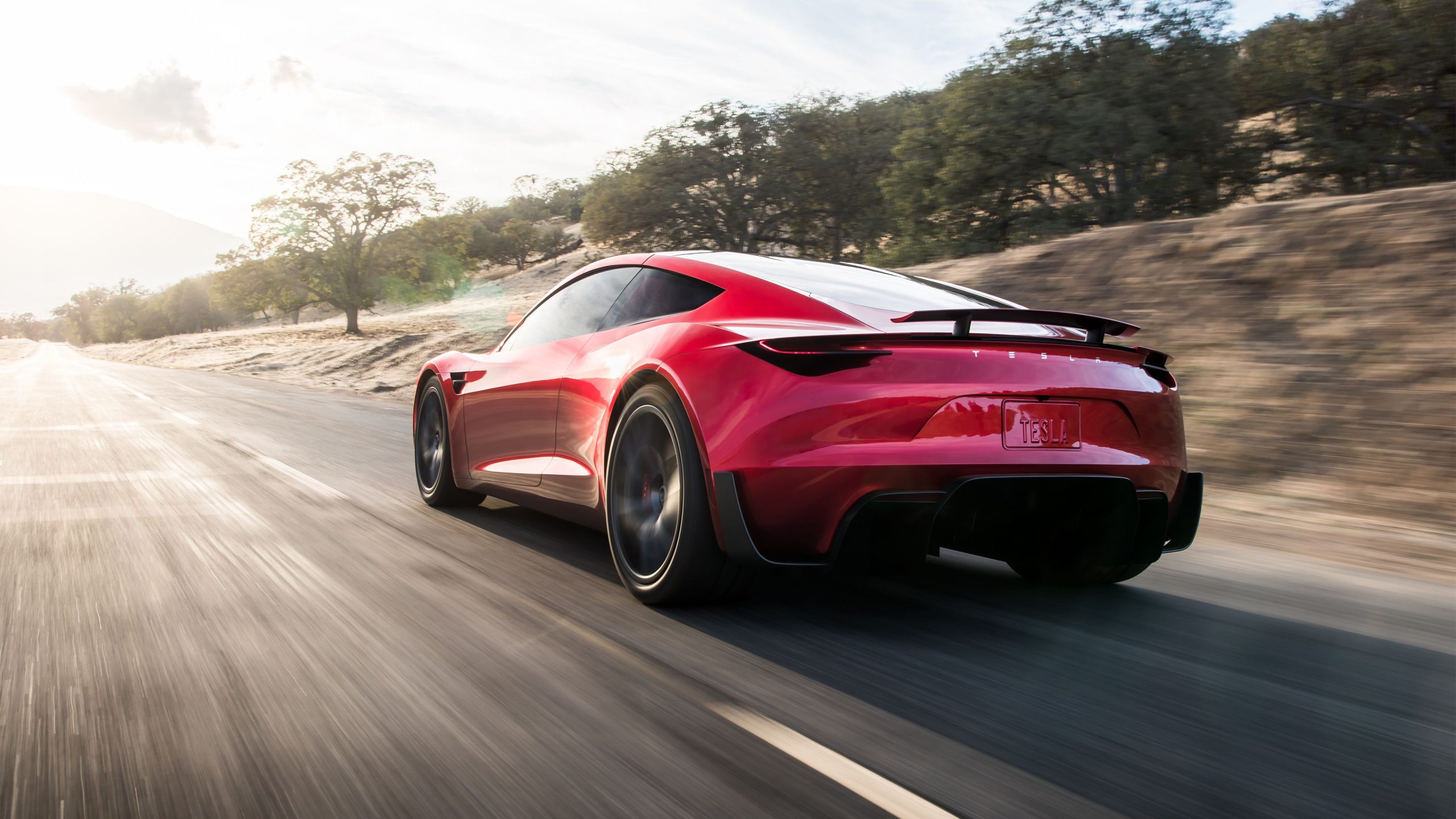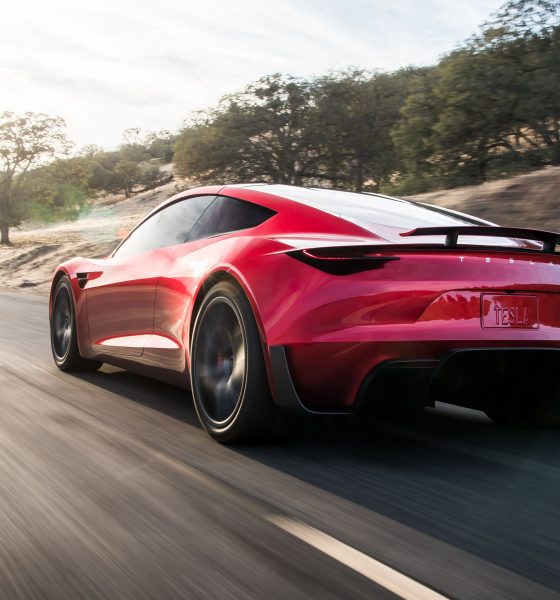

News
Tesla Roadster’s ‘SpaceX package’ with rocket thrusters could actually work
This weekend proved to be a fruitful one for Elon Musk’s Twitter followers and fans of the next-generation Tesla Roadster, as the billionaire entrepreneur discussed, in honest-to-goodness seriousness, how the electric car maker would utilize SpaceX technology to make the upcoming all-electric supercar an absolute monster on wheels. Needless to say, there was quite a lot to take in.
Musk started off his Twitter discussion on the next-generation Roadster by stating that the car will feature ~10 rocket thrusters that are “arranged seamlessly around (the) car.” Musk further noted that the thrusters would “dramatically” improve acceleration, braking, and cornering, to the point that the Roadster would be able to fly — a reaffirmation of his previous statement referring to the vehicle having the capability to fly “short hops.”
Musk noted that Tesla would be using SpaceX’s Composite Overwrapped Pressure Vessel (COPV), a container consisting of a thin, non-structural liner wrapped with a structural fiber composite. COPVs are designed to hold a fluid under pressure, and are used by SpaceX’s first-stage rocket boosters during re-entry and landing. Musk further explained the use of SpaceX’s technology in later tweets.
SpaceX option package for new Tesla Roadster will include ~10 small rocket thrusters arranged seamlessly around car. These rocket engines dramatically improve acceleration, top speed, braking & cornering. Maybe they will even allow a Tesla to fly …
— Elon Musk (@elonmusk) June 9, 2018
While the idea of using rocket propulsion to enhance the performance of an all-electric supercar might seem to be well into the realms of science fiction, using COPVs for the next-gen Roadster is actually pretty feasible, at least from a technical standpoint. SpaceX’s COPVs have operating pressures of around 350 bars (5,000 psi) and too powerful for a land vehicle. If Tesla installs a similar version of SpaceX’s upper stage thrusters that are used in guiding rockets, rear-mounted devices could store just enough compressed air to provide Tesla’s next-gen Roadster an additional boost in acceleration for a short duration.
Note, gas contained would be ultra high pressure air in a SpaceX rocket COPV bottle. The air exiting the thrusters would immediately be replenished whenever vehicle pack power draw allowed operation of the air pump, which is most of the time.
— Elon Musk (@elonmusk) June 10, 2018
Rocket thrusters placed in front of the vehicle that provides thrust opposite of the Roadster’s direction of travel, at least in concept, could help the electric car’s braking capability, while thrusters placed along each side of the vehicle can help in cornering by providing lateral force. In order to accomplish this, however, Tesla would have to carefully balance the weight of components from the upgraded SpaceX package – Musk noted that the vehicle would sacrifice its rear seats from the standard 2+ 2 configuration to accommodate the additional hardware – with output from the rocket thrusters to maximize the vehicle’s performance. Onboard electric air pumps would repressurize the space-grade containers when they were depleted, making for repeat fun, at least in a theoretical sense. Musk also stated that SpaceX COPVs that will be used for the next-generation Roadster will be durable, and be “literally bulletproof.”
Exactly. Total energy stored even in ultra compressed air is low vs battery, but power output is insane. The composite overwrapped pressure vessel (COPV) is most advanced ever made. It’s what SpaceX is qualifying for NASA crewed missions. Extremely robust — literally bulletproof.
— Elon Musk (@elonmusk) June 10, 2018
Overall, Musk reiterated that the next-generation Tesla Roadster is designed to be the best car in the industry when it gets released. During his tweetstorm, Musk mentioned that with the all-electric supercar, Tesla is attempting to beat ICE vehicles on “every performance metric;” thus transferring the “halo crown effect” gas cars have as the top speed standards in the automotive market.
New details about Tesla’s next-generation Roadster have been released by Elon Musk lately. The SpaceX option for the vehicle was announced during the 2018 Annual Shareholder Meeting, and not long after that, Musk also revealed that the vehicle would feature an “Augmented Mode” designed to “enhance human driving ability,” thereby providing assistance to drivers who would be operating the insanely powerful supercar.
During the unveiling of the next-generation Tesla Roadster, Elon Musk noted that the purpose of the all-electric supercar is to give a “hardcore smackdown” to gasoline-powered cars. The specs of the vehicle that were unveiled then, which are representative of the all-electric supercar’s base trim, are already record-breaking, including a 0-60 mph time of 1.9 seconds, a quarter-mile time of 8.9 seconds, a top speed of over 250 mph, 620 miles of range thanks to a 200 kWh battery, and 10,000 Nm of torque. With the Roadster’s SpaceX option, the all-electric supercar could very well establish a new class of vehicles that lie beyond the hypercar echelon.

Elon Musk
Elon Musk and Tesla AI Director share insights after empty driver seat Robotaxi rides
The executives’ unoccupied tests hint at the rapid progress of Tesla’s unsupervised Robotaxi efforts.

Tesla CEO Elon Musk and AI Director Ashok Elluswamy celebrated Christmas Eve by sharing personal experiences with Robotaxi vehicles that had no safety monitor or occupant in the driver’s seat. Musk described the system’s “perfect driving” around Austin, while Elluswamy posted video from the back seat, calling it “an amazing experience.”
The executives’ unoccupied tests hint at the rapid progress of Tesla’s unsupervised Robotaxi efforts.
Elon and Ashok’s firsthand Robotaxi insights
Prior to Musk and the Tesla AI Director’s posts, sightings of unmanned Teslas navigating public roads were widely shared on social media. One such vehicle was spotted in Austin, Texas, which Elon Musk acknowleged by stating that “Testing is underway with no occupants in the car.”
Based on his Christmas Eve post, Musk seemed to have tested an unmanned Tesla himself. “A Tesla with no safety monitor in the car and me sitting in the passenger seat took me all around Austin on Sunday with perfect driving,” Musk wrote in his post.
Elluswamy responded with a 2-minute video showing himself in the rear of an unmanned Tesla. The video featured the vehicle’s empty front seats, as well as its smooth handling through real-world traffic. He captioned his video with the words, “It’s an amazing experience!”
Towards Unsupervised operations
During an xAI Hackathon earlier this month, Elon Musk mentioned that Tesla owed be removing Safety Monitors from its Robotaxis in Austin in just three weeks. “Unsupervised is pretty much solved at this point. So there will be Tesla Robotaxis operating in Austin with no one in them. Not even anyone in the passenger seat in about three weeks,” he said. Musk echoed similar estimates at the 2025 Annual Shareholder Meeting and the Q3 2025 earnings call.
Considering the insights that were posted Musk and Elluswamy, it does appear that Tesla is working hard towards operating its Robotaxis with no safety monitors. This is quite impressive considering that the service was launched just earlier this year.
Elon Musk
Starlink passes 9 million active customers just weeks after hitting 8 million
The milestone highlights the accelerating growth of Starlink, which has now been adding over 20,000 new users per day.

SpaceX’s Starlink satellite internet service has continued its rapid global expansion, surpassing 9 million active customers just weeks after crossing the 8 million mark.
The milestone highlights the accelerating growth of Starlink, which has now been adding over 20,000 new users per day.
9 million customers
In a post on X, SpaceX stated that Starlink now serves over 9 million active users across 155 countries, territories, and markets. The company reached 8 million customers in early November, meaning it added roughly 1 million subscribers in under seven weeks, or about 21,275 new users on average per day.
“Starlink is connecting more than 9M active customers with high-speed internet across 155 countries, territories, and many other markets,” Starlink wrote in a post on its official X account. SpaceX President Gwynne Shotwell also celebrated the milestone on X. “A huge thank you to all of our customers and congrats to the Starlink team for such an incredible product,” she wrote.
That growth rate reflects both rising demand for broadband in underserved regions and Starlink’s expanding satellite constellation, which now includes more than 9,000 low-Earth-orbit satellites designed to deliver high-speed, low-latency internet worldwide.
Starlink’s momentum
Starlink’s momentum has been building up. SpaceX reported 4.6 million Starlink customers in December 2024, followed by 7 million by August 2025, and 8 million customers in November. Independent data also suggests Starlink usage is rising sharply, with Cloudflare reporting that global web traffic from Starlink users more than doubled in 2025, as noted in an Insider report.
Starlink’s momentum is increasingly tied to SpaceX’s broader financial outlook. Elon Musk has said the satellite network is “by far” the company’s largest revenue driver, and reports suggest SpaceX may be positioning itself for an initial public offering as soon as next year, with valuations estimated as high as $1.5 trillion. Musk has also suggested in the past that Starlink could have its own IPO in the future.
News
NVIDIA Director of Robotics: Tesla FSD v14 is the first AI to pass the “Physical Turing Test”
After testing FSD v14, Fan stated that his experience with FSD felt magical at first, but it soon started to feel like a routine.

NVIDIA Director of Robotics Jim Fan has praised Tesla’s Full Self-Driving (Supervised) v14 as the first AI to pass what he described as a “Physical Turing Test.”
After testing FSD v14, Fan stated that his experience with FSD felt magical at first, but it soon started to feel like a routine. And just like smartphones today, removing it now would “actively hurt.”
Jim Fan’s hands-on FSD v14 impressions
Fan, a leading researcher in embodied AI who is currently solving Physical AI at NVIDIA and spearheading the company’s Project GR00T initiative, noted that he actually was late to the Tesla game. He was, however, one of the first to try out FSD v14.
“I was very late to own a Tesla but among the earliest to try out FSD v14. It’s perhaps the first time I experience an AI that passes the Physical Turing Test: after a long day at work, you press a button, lay back, and couldn’t tell if a neural net or a human drove you home,” Fan wrote in a post on X.
Fan added: “Despite knowing exactly how robot learning works, I still find it magical watching the steering wheel turn by itself. First it feels surreal, next it becomes routine. Then, like the smartphone, taking it away actively hurts. This is how humanity gets rewired and glued to god-like technologies.”
The Physical Turing Test
The original Turing Test was conceived by Alan Turing in 1950, and it was aimed at determining if a machine could exhibit behavior that is equivalent to or indistinguishable from a human. By focusing on text-based conversations, the original Turing Test set a high bar for natural language processing and machine learning.
This test has been passed by today’s large language models. However, the capability to converse in a humanlike manner is a completely different challenge from performing real-world problem-solving or physical interactions. Thus, Fan introduced the Physical Turing Test, which challenges AI systems to demonstrate intelligence through physical actions.
Based on Fan’s comments, Tesla has demonstrated these intelligent physical actions with FSD v14. Elon Musk agreed with the NVIDIA executive, stating in a post on X that with FSD v14, “you can sense the sentience maturing.” Musk also praised Tesla AI, calling it the best “real-world AI” today.








